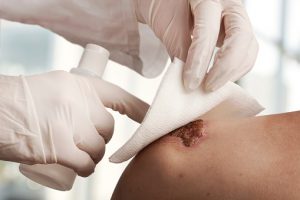The earliest records of wound healing techniques date back to 2500 BC from ancient Egypt. Wounds were believed to have a spiritual component back then and so part of the healing process involved using donkey feces to ward off evil spirits. This actually seemed to work owing to an antibacterial effect of the material used. As time passed, wound healing was aided by techniques that provided an antibiotic effect and included the washing of wounds with herbs, minerals, milk, and water. Hippocrates in Greece, around 400 BC described using wine or vinegar as materials needed to cleanse the wound of impurities.
As wound healing progressed it became apparent that a covering might help to protect it from further harm. After the wounds were thoroughly washed, they were dressed in wool that had been boiled in water. Cotton gauze became more widely used around the fifth century BC and was used for centuries until synthetic materials like rayon were developed in the 20th century that were more effective. Also, during the 20th century different materials were developed that were better suited to covering a wound without sticking, allowed for air to penetrate and that also contained substances that promoted quicker healing.
During the 20th century antibacterial dressings were more commonly used to keep the wounds free of bacteria. Interestingly, honey which had been employed for thousands of years was found to still be very effective as a wound healing agent because of its antimicrobial and anti-inflammatory properties. Throughout history, many of the wound healing materials were developed on the battlefield. Iodine which was used as an antiseptic was used during WW I to treat gangrenous battlefield wounds and later found its way to the general public.
As advanced as the field of wound healing is today, many of the techniques developed in ancient times are still incorporated in the treatment of wounds today. It is a constantly evolving field of medicine and as wounds become more complex, so do the treatment options.
If you have a chronic or non-healing wound, you may be a candidate for Flushing Hospital Medical Center’s outpatient Wound Care Center. To schedule an appointment or speak with a clinician, please call 718-670-4542.
All content of this newsletter is intended for general information purposes only and is not intended or implied to be a substitute for professional medical advice, diagnosis or treatment. Please consult a medical professional before adopting any of the suggestions on this page. You must never disregard professional medical advice or delay seeking medical treatment based upon any content of this newsletter. PROMPTLY CONSULT YOUR PHYSICIAN OR CALL 911 IF YOU BELIEVE YOU HAVE A MEDICAL EMERGENCY.

